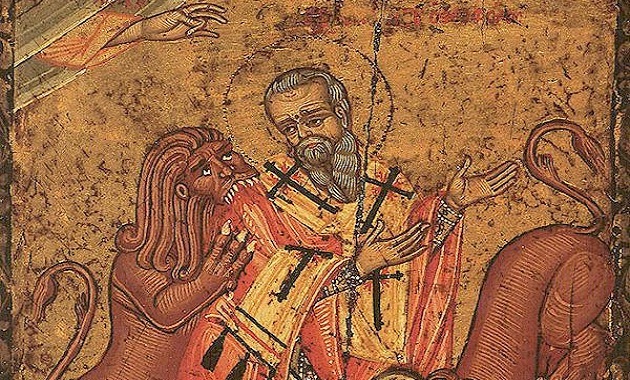Saint Ignatios and the Antiochean Church
11 February 2013On the occasion of the commemoration of the translation of the holy relics of Saint Ignatios the God-bearer, we would like to add a little information concerning his relationship with the local Church, in an effort to respond to the following questions:
Who was the first bishop of the city? And what position did Ignatios hold in the local registry of bishops?
Some evidence has survived to suggest that Saint Peter was the first Bishop of Antioch. This information goes against the practice of the ancient Church which was that apostles who had founded a local church were not then appointed as bishop. Should we, for example, consider Saint Paul the first bishop of the city of Athens, or of Corinth? Clearly not. Founder, yes, bishop, no.
The last Biblical reference to the presence of Saint Peter in Antioch is to be found in verses 11-14 of the second chapter of the Epistle to the Galatians, where his encounter with Saint Paul is mentioned. This event can be dated to the year 49 A.D., around March. From that time on, there is no solid evidence to link Saint Peter with this city. If Saint Ignatios succeeded Saint Peter, then he must have been bishop of the city until his martyrdom in about 115, in other words for a period of 65 years.
It is at this point that Saint Evodios appears, since certain sources agree that he served in the city from the time of the Apostolic Synod (end of 48 A.D.) until about 70 A.D., which would make the time of Ignatios as Bishop of Antioch more reasonable: from A.D. 70 to perhaps 115 (45 years), Saint Jerome, in fact, notes in his Chronicle, that Saint Ignatios became bishop of the city in the year 68 A.D.
The time of Saint Evodios’ elevation to the throne of Antioch cannot be determined with any precision, but it seems that the period when he was shepherd in Antioch extended from the middle of the 40s until the end of the 60s. If this is so, then, for a time, both Saint Peter and Saint Paul would have been in Antioch while Evodios was bishop.
Evsevios (Eusebius) of Caesarea (P.G. 19. 540 and 20.256C) informs us that Saint Evodios was the first bishop of the local Church, from about 44. A.D., while elsewhere he places the elevation of Saint Ignatios to the Episcopal throne of the city in the year 69 A.D.
Based on this fragmentary evidence, then, we may say that Saint Ignatios was Bishop of Antioch, as the successor to Saint Evodios, from circa 69/70 until his martyrdom in 115 [This date is disputed, trans. note].
Although the extant evidence is scanty, it indicates that the proper succession of the pastors of the local Church is as follows:
1. Saint Peter, for as long as he remained in the city, but not as bishop.
2. Saint Evodios , from the mid-40s until the end of the 60s.
3. Saint Ignatios, from 70 A.D. until the time of his martyrdom, in the reign of Trajan (98-117).







